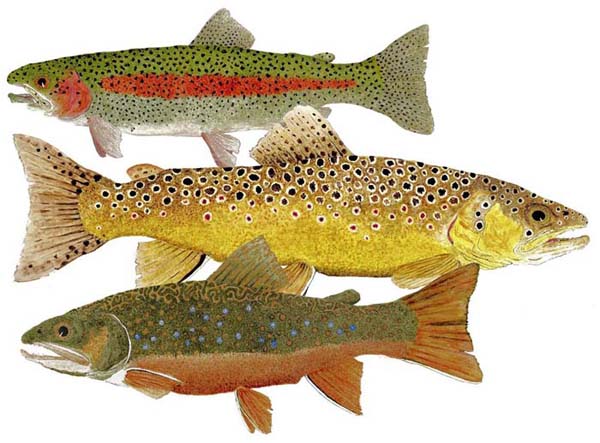
The native Appalachian brookies on the North Georgia/North Carolina border [Eberle Farmstead], according to Angie Roth are brighter than the illustration indicates, but so rare that only Angie has ever caught one ‘on the family property’ in the last dozen or so years. Images provided courtesy of Thom Glace, award-winning artist.
By Skip Clement
[dropcap]D[/dropcap]uring a long, hot, dry spell too early in June to be considered expected, Angie and I waited and waited for it to cool off hoping a little rain would pony up even better fishing on the Soque (so-quee) River. That patience ended with more rain, and high water that bollixed booked guide days.
So we headed to the her family [Eberle] Farmstead on the North Georgia/North Carolina border where the rain had petered out
We had decided to arrive late, eat in town, then head to the farm and fish at night. We had focused on a leech pattern made out of pine squirrel tail. A reader had sent me a YouTube link and it was tied by Tim Flagler, Tightline Productions, who, like me, and our reader, was a fan of pine squirrel tail. It’s advantage – a swimmer like no other material so cheap.
The idea of fishing it at night was not mine or Angie’s, but Tim’s himself who bragged, as you’ll see in the video, about the patterns evening prowess with big browns. The intrigue there is we had not caught any of the Eberle Farmstead’s famed double-digit brown trout yet this year. Angie was bursting with optimism.
I tied up two dozen with half, as usual, just as Flagler called out, and 12 my version, which was all tube flies
Conclusion: Angie did catch two brown trout the first night – one might have been 10-pounds, the other maybe 5/6-pounds along with a nice 4-pound rainbow, all on tube flies. I managed not to fall more than normal, but did not get on the scoreboard until the second evening just before dark – about a 4-pound brown. So, darkness browns it is, Tim.
NOTE: Running the craft foam along the shank of the hook to within one eye hook measurement and leaving a nubbin’ to support the fur just beyond the hook bend has a big impact on the fly’s success.






